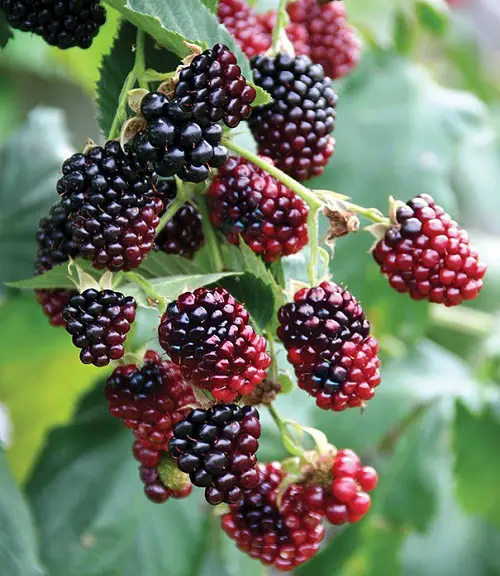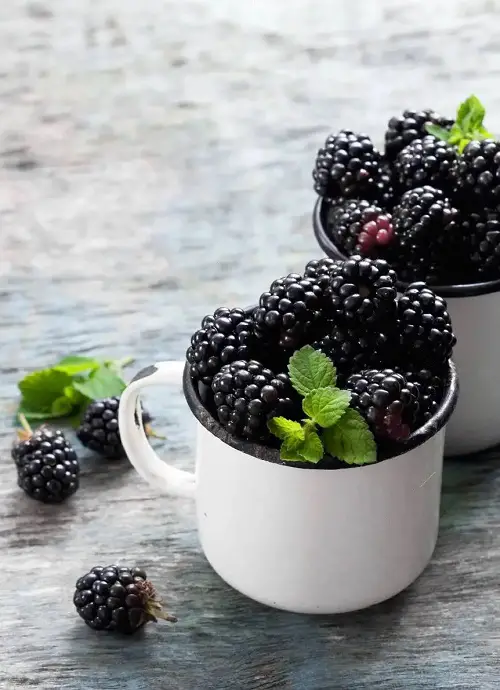Check out this berry battle in this Boysenberry vs. Blackberry post where we will list out the differences and similarities!
Read this Boysenberry vs. Blackberry guide to find differences and similarities between the two and get clarity once and for all!
What is Boysenberry?
Boysenberry is a hybrid berry that combines characteristics from several different types of berries, including the European raspberry (Rubus idaeus), European blackberry (Rubus fruticosus), American dewberry (Rubus aboriginum), and loganberry (Rubus × loganobaccus).
The result is a large, dark purple to blackish berry with a juicy, sweet-tart flavor. It’s often described as having a rich, complex taste that is reminiscent of raspberries, blackberries, and even a hint of floral notes.
Rudolph Boysen first cultivated the boysenberry in California in the early 1920s. Walter Knott of Knott’s Berry Farm popularized the berry by selling the fruit and its products, such as jams and pies.
What is Blackberry?
The blackberry is a perennial plant which belongs to the Rosaceae family and is part of the Rubus genus. The term “blackberry” is used to describe several different species, many of which are native to regions in Asia, Europe, North, and South America. They are well-known for their dark, glossy fruits that are typically sweet and slightly tart when fully ripe.
Blackberries grow on arching canes, or “brambles,” which can be quite thorny (although there are also thornless varieties). The leaves are typically green and oval or heart-shaped. The berries themselves are not true berries but are actually an aggregate fruit composed of small drupelets.
Boysenberry vs. Blackberry
1. Botanical Origin
- Boysenberry: The boysenberry is a large bramble fruit, considered a variety of blackberry (Rubus ursinus). It’s believed to be a cross between a blackberry and a loganberry or red raspberry. Horticulturist Rudolph Boysen developed the fruit in the 1920s, and farmer Walter Knott later commercialized it.
- Blackberry: Blackberries are fruits of the Rubus genus in the Rosaceae family. There are several species of blackberries, and they grow naturally in various parts of the world.
2. Hardiness Zones
Blackberries and boysenberries can grow in similar areas, but boysenberries prefer slightly milder climates. Blackberries can thrive in hardiness zones 5 to 10, while boysenberries prefer zones 5 to 9.
Since there are many sturdy blackberry varieties, they can grow in more places compared to the more delicate boysenberries.
- Boysenberry: 5-9; grows on low vines
- Blackberry: 5-10; grows on a bush
3. Appearance
- Boysenberry: Boysenberries are generally larger than blackberries, with a reddish-purple to dark purple color when ripe. They have a soft texture and are characterized by their elongated shape.
- Blackberry: Blackberries are usually smaller than boysenberries, and as the name suggests, they are black when fully ripe. They have a round shape with a cluster of small drupelets.
4. Taste and Flavor
- Boysenberry: Boysenberries have a unique flavor profile, often described as a combination of sweet and tart, with subtle hints of raspberry and blackberry. The flavor is more complex compared to blackberries.
- Blackberry: Blackberries have a sweet and slightly tart taste, with a more straightforward flavor compared to boysenberries.
5. Texture
- Boysenberry: Boysenberries have a soft and tender texture, making them great for eating fresh, baking into pies, or making jams and preserves.
- Blackberry: Blackberries are also soft but can be slightly firmer than boysenberries.
6. Cultivation
- Boysenberry: Boysenberries can be more challenging to grow compared to blackberries due to their hybrid nature. They require specific growing conditions, including well-drained soil and adequate sunlight.
- Blackberry: Blackberries are relatively easier to grow and are more widely cultivated in various regions around the world.
7. Usage
- Boysenberry: Boysenberries are popular in making jams, jellies, syrups, pies, and other desserts. They also taste great when fresh.
- Blackberry: Blackberries have a wide range of culinary uses, including in desserts, preserves, baking, salads, and beverages. They taste great when fresh too!
8. Availability
- Boysenberry: Boysenberries may be less common in grocery stores due to their limited cultivation compared to blackberries.
- Blackberry: Blackberries are more widely available and are a common sight in grocery stores and farmers’ markets during their peak season.





